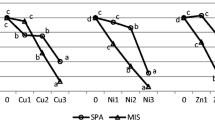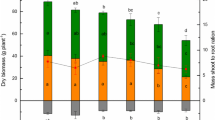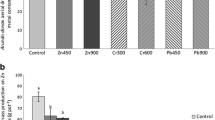Abstract
We used greenhouse experiments to evaluate cesium (Cs) uptake by four grasses, Agropyron spicatum (Pursh) Scribn & Smith, Leymus cinereus Scribn & Merr., Agropyron cristatum (L.) Gaertn. and Bromus tectorum L., to determine their potential as phytoremediation agents for Cs-contaminated soils. These four species grow well in the Intermountain region of western North America primarily on moderately coarse to coarsely textured soils where annual precipitation ranges from 20 to 50 cm. Whereas A. cristatum and B. tectorum are introduced species from Asia and the Mediterranean region of Europe, respectively, A. spicatum and L. cinereus are native to the Great Plains and Intermountain regions of North America. Plants were grown under two treatments each of: (1) soil Cs (ambient and 50 mg kg−1 + ambient), (2) soil fertility (ambient and ambient + 40 mg N kg−1 and 60 mg P kg−1), and 3) soil moisture (35% and 70% water holding capacity of the potted soils). Shoot Cs concentration in high soil Cs treatments was approximately ten times greater than in low soil Cs treatments. Even though shoot Cs concentrations tended to be lower in high soil Cs-high fertility-high soil moisture treatments than in high soil Cs-ambient fertility-low soil moisture treatments, total Cs uptake was greater because shoot biomass was approximately ten-fold greater. Shoots did not show signs of Cs toxicity in the high soil Cs treatments. We concluded, however, based on the low transfer factors (∼1.0) for all these grasses, that none were strong candidates as phytoremediation agents for Cs-contaminated soils.






Similar content being viewed by others
References
Anderson JE, Inouye RS (2001) Landscape-scale changes in plant species and abundance and biodiversity of a sagebrush steppe over 45 years. Ecol Monogr 71:531–556
Bakker J, Wilson S (2001) Competitive abilities of introduced and native grasses. Plant Ecol 157:117–125 doi:10.1023/A:1013972403293
Beckstead JS, Meyer E, Allen PS (1995) Effects of afterripening on cheatgrass (Bromus tectorum) and Squirreltail (Elymus elymoides) germination. In: Roundy BA, McArthur ED, Haley JS, Mann DK (comps) Proceeedings: wildland shrub and arid land restoration symposium; 1993 October 19–21; Las Vegas, NV. Gen. Tech. Rep. INT-GTR-315. Ogden, UT; U.S. Department of Agriculture, Forest Service, Intermountain Research Station
Berrow ML (1988) Sampling of soils and plants for trace element analysis. Anal Proc 25:116–118
Broadley MR, Willey NJ (1997) Differences in root uptake of radiocesium by 30 plant taxa. Environ Pollut 97:11–15 doi:10.1016/S0269-7491(97)00090-0
Broadley MR, Willey NJ, Philippidis C, Dennis ER (1999) A comparison of caesium uptake kinetics in eight species of grass. J Environ Radioact 46:225–236 doi:10.1016/S0265-931X(98)00128-3
Cline JF, Hungate FP (1960) Accumulation of potassium, cesium137 and rubidium86 in bean plants grown in nutrient solutions. Plant Physiol 35:826–829 doi:10.1104/pp.35.6.826
Cook LL, Inouye RS, McGonigle TP, White GJ (2007) The distribution of stable cesium in soils and plants of the eastern Snake River Plain in southern Idaho. J Arid Environ 69:40–64 doi:10.1016/j.jaridenv.2006.08.014
Cook LL, McGonigle TP, Inouye RS (2009) Titanium as an indicator of residual soil on arid-land plants. J Environ Qual 38:188–199 doi:10.2134/jeq2007.0034
Delvaux B, Kruyts N, Cremers A (2000) Rhizospheric mobilization of radiocesium in soils. Environ Sci Technol 34:1489–1493 doi:10.1021/es990658g
Delvaux B, Kruyts N, Maes E, Smolders E (2001) Fate of radiocesium in soil and rhizosphere. In: Gobran GR, Wenzel WW, Lombi E (eds) Trace elements in the rhizosphere. CRC Pr, Boca Raton, pp 61–91
Djingova R, Kuleff I (1994) On the sampling of vascular plants for monitoring of heavy metal pollution. In: Markert B (ed) Environmental sampling for trace analysis. VCH, New York, pp 395–414
Dushenkov S (2003) Trends in phytoremediation of radionuclides. Plant Soil 249:167–175 doi:10.1023/A:1022527207359
Dushenkov S, Mikheev A, Prokhnevsky A, Ruchko M, Sorochinsky B (1999) Phytoremediation of radiocesium-contaminated soil in the vicinity of Chernobyl, Ukraine. Environ Sci Technol 33:469–475 doi:10.1021/es980788+
Entry JA, Watrud LS (1998) Potential remediation of Cs-137 and Sr-90 contaminated soil by accumulation in Alamo switchgrass. Water Air Soil Pollut 104(3–4):339–352 doi:10.1023/A:1004994123880
Entry JA, Watrud LS, Manassee RS, Vance NC (1997) Phytoremediation and reclamation of soils contaminated with radionuclides. In: Kruger EL, Anderson TA, Coats JR (eds) Phytoremediation of soil and water contaminants, ACS Symposium Series 664. American Chemical Society, Washington DC, pp 299–306
Faucon M-P, Shutcha MN, Meerts P (2007) Revisiting copper and cobalt concentrations in supposed hyperaccumulators from SC Africa: influence of washing and metal concentrations in soil. Plant Soil 301:29–36 doi:10.1007/s11104-007-9405-3
Francis MG, Pyke DA (1996) Crested wheatgrass-cheatgrass seedling competition in a mixed-density design. J Range Manage 49:432–438 doi:10.2307/4002925
Gerzabek MH, Strebl F, Temmel B (1998) Plant uptake of radionuclides in lysimeter experiments. Environ Pollut 99:93–103 doi:10.1016/S0269-7491(97)00167-X
Hall GEM (1995) Sample preparation and decomposition. In: Brooks RR, Dunn CE, Hall GEM (eds) Biological systems in mineral exploration and processing. Ellis Horwood, New York, pp 427–442
Hampton CR, Bowen HC, Broadley MR, Hammond JP, Mead A, Payne KA, Pritchard JP, White PJ (2004) Cesium toxicity in Arabidopsis. Plant Physiol 136:3824–3837 doi:10.1104/pp.104.046672
Harris GA (1967) Some competitive relationships between Agropyron spicatum and Bromus tectorum. Ecol Monogr 37:89–111 doi:10.2307/2937337
Hermans C, Hammond JP, White PJ, Verbruggen N (2006) How do plants respond to nutrient shortage by biomass allocation? Trends Plant Sci 11:610–617 doi:10.1016/j.tplants.2006.10.007
Hitchcock CL, Cronquist A (1973) Flora of the Pacific Northwest. Univ. Washington Press, Seattle
Hitchcock CL, Cronquist A, Ownbey M, Thompson JW (1969) Vascular plants of the Pacific Northwest. Univ. Washington Press, Seattle
James JJ (2008) Effect of soil nitrogen stress on the relative growth rate of annual and perennial grasses in the Intermountain West. Plant Soil 310:201–210 doi:10.1007/s11104-008-9645-x
Judd WS, Campbell CS, Kellogg EA, Stevens PF (2008) Plant systematics: a phylogenetic approach, 3rd edn. Sinauer Associates, Sunderland
Knapp PA (1996) Cheatgrass (Bromus tectorum L.) dominance in the Great Basin Desert. Glob Environ Change 6:37–52 doi:10.1016/0959-3780(95)00112-3
Kordan HA (1987) Reversal of caesium inhibition of growth by potassium in hypocotyls of tomato seedlings (Lycopersicon esculentum L.). New Phytol 107:395–401 doi:10.1111/j.1469-8137.1987.tb00191.x
Lasat MM, Norvell WA, Kochian LV (1997) Potential for phytoextraction of 137Cs from a contaminated soil. Plant Soil 195:99–106 doi:10.1023/A:1004210110855
Lasat MM, Fuhrmann M, Ebbs SD, Cornish JE, Kochian LV (1998) Phytoremediation of a radiocesium-contaminated soil: Evaluation of cesium-137 bioaccumulation in the shoots of three plant species. J Environ Qual 27:165–169
Lee S (2000) Putting plants to work: The ANL-West phytoremediation first-year field season demonstration. Radwaste Solut 7:49–54
Lombi E, Zhao FJ, Dunham SJ, McGrath SP (2001) Phytoremediation of heavy metal-contaminated soils: Natural hyperaccumulation versus chemically enhanced phytoextraction. J Environ Qual 30:1919–1926
McGrath CL (1987) Soil survey of Bannock County Area, Idaho (parts of Bannock and Power Counties). USDA Soil Conservation Service in cooperation with US Dept. of the Interior, Bureau of Land Management; University of Idaho College of Agriculture; and Idaho Soil Conservation Commission
McGrath SP, Zhao FJ (2003) Phytoextraction of metals and metalloids from contaminated soils. Curr Opin Biotechnol 14:277–282 doi:10.1016/S0958-1669(03)00060-0
National Research Council (NRC) (1999) Introduction: DOE’s groundwater and soil contamination problem. In: NRC (ed) Groundwater and Soil Cleanup: Improving management of persistent contaminants. National Academy Press, Washington DC, pp 15–38
Sahr T, Voigt G, Schimmack W, Paretzke HG, Ernst D (2005) Low-level radiocaesium exposure alters gene expression in roots of Arabidopsis. New Phytol 168:141–148 doi:10.1111/j.1469-8137.2005.01485.x
Shaw G, Bell JNB (1989) The kinetics of caesium absorption by roots of winter wheat and the possible consequences for the derivation of soil-to-plant transfer factors for radiocaesium. J Environ Radioact 10:213–231 doi:10.1016/0265-931X(89)90026-X
Smith SD, Monson RK, Anderson JE (1997) Physiological ecology of North American desert plants. Springer, New York
Sperry LJ, Belnap J, Evans D (2006) Bromus tectorum invasion alters nitrogen dynamics in an undisturbed arid grassland ecosystem. Ecol 87:603–615 doi:10.1890/05-0836
Tennant D (1975) A test of a modified line intersect method of estimating root length. J Ecol 63:995–1001 doi:10.2307/2258617
U. S. Environmental Protection Agency (1996) Method 3050B, Acid digestion of sediments, sludges, and soils, Rev. 2. http://www.epa.gov/epaoswer/hazwaste/test/pdfs/3050b.pdf
Vasquez E, Sheley R, Svejcar T (2008) Nitrogen enhances the competitive ability of cheatgrass (Bromus tectorum) relative to native grasses. Invasive Plant Sci Manage 1:287–295 doi:10.1614/IPSM-08-062.1
Wallace A, Romney EM, Wood RA (1982) The role of stable cesium on plant uptake of cesium-137. Soil Sci 134:71–75
Wendling LA, Harsh JB, Palmer CD, Hamilton MA, Flury M (2004) Cesium sorption to illite as affected by oxalate. Clays Clay Miner 52:375–381 doi:10.1346/CCMN.2004.0520312
White PJ, Broadley MR (2000) Mechanisms of caesium uptake by plants. Tinsley Review No. 113. New Phytol 147:241–256 doi:10.1046/j.1469-8137.2000.00704.x
White PJ, Swarup K, Escobar-Gutierrez AJ, Bowen HC, Wiley NJ, Broadley MR (2003) Selecting plants to minimize radiocaesium in the food chain. Plant Soil 249:177–186 doi:10.1023/A:1022593307224
Willey N, Hall S, Mudiganti A (2001) Assessing the potential of phytoremediation at a site in the U.K. contaminated with 137Cs. Int J Phytoremediation 3:321–333 doi:10.1080/15226510108500062
Zhu Y-G, Smolders E (2000) Plant uptake of radiocaesium: a review of mechanisms, regulation and application. J Exp Bot 51:1635–1645 doi:10.1093/jexbot/51.351.1635
Zhu Y-G, Shaw G, Nisbet AF, Wilkins BT (2000) Effect of potassium starvation on the uptake of radiocaesium by spring wheat (Triticum aestivum cv. Tonic). Plant Soil 220:27–34 doi:10.1023/A:1004789915175
Acknowledgements
We thank P. Cook, M. Hamilton, A. Herera, Dr. A. Ray, J. Bala, Dr. R. Williams, S. Mathies, Dr. C. Radtke, M. Radtke, and D. Key for assistance in providing supplies and equipment, setting up experiments, and sample processing. We are grateful to J. Taylor and Dr. R. Smith, University of Idaho in Idaho Falls, for use of facilities and advice for ICP-MS analysis. Bromus tectorum seeds and helpful information on seed germination were provided by Dr. J. Beckstead, Gonzaga University, Spokane, WA. Agropyron spicatum seeds were provided by Dr. M. Germino, ISU. We thank two anonymous reviewers for their comments that greatly improved the quality of this paper. Funds and support for this project were provided by the ISU Department of Biological Sciences, the ISU Center for Ecological Research and Education, the Inland Northwest Research Alliance, the ISU Graduate Student Research and Scholarship Committee, a Bechtel Educational Outreach Program grant awarded to R. Inouye, the Idaho National Science Foundation Experimental Program to Stimulate Cooperative Research, and Sigma Xi. For Inouye, this work was supported by the National Science Foundation IRD Program, however any opinion, finding, and conclusions or recommendations expressed in this paper are those of the authors and do not necessarily reflect the views of the National Science Foundation.
Author information
Authors and Affiliations
Corresponding author
Additional information
Responsible Editor: Fangjie J. Zhao.
Rights and permissions
About this article
Cite this article
Cook, L.L., Inouye, R.S. & McGonigle, T.P. Evaluation of four grasses for use in phytoremediation of Cs-contaminated arid land soil. Plant Soil 324, 169–184 (2009). https://doi.org/10.1007/s11104-009-9942-z
Received:
Accepted:
Published:
Issue Date:
DOI: https://doi.org/10.1007/s11104-009-9942-z




